Micro-Handguns of SHOT Show 2017
Pocket-Sized Fire Power Makes it Easy to Always Have a Gun
 Diminutive handguns are nothing new; Henry Deringer’s eponymous Philadelphia model was produced and sold from 1852 and tiny, eminently concealable firearms have been popular for at least as long. Nihil novi sub sole; at SHOT Show 2017 a number of manufacturers showcased the continuation (and expansion) of this corner of the firearms market.
Diminutive handguns are nothing new; Henry Deringer’s eponymous Philadelphia model was produced and sold from 1852 and tiny, eminently concealable firearms have been popular for at least as long. Nihil novi sub sole; at SHOT Show 2017 a number of manufacturers showcased the continuation (and expansion) of this corner of the firearms market.
Bond Arms, the largest modern manufacturer of derringers, is probably the closest living cousin of the early models. For just over 20 years, Bond Arms has been creating small(ish) non-repeating break-open handguns with caliber-swapable double barrels (available in everything from .22LR rimfire to .45 centerfire to .410 shotshells) reminiscent of early pocket guns like the ones that might be found in a frontier gambler’s vest pocket. More recently, Bond added a more modern touch to their pocket gun lineup when they acquired Boberg Arms’s design for a semi-auto bullpup pistol that strips rounds rearward from the nose-down magazine before chambering them. Although they are small and classified as derringers, neither Bond offering could realistically be called “tiny” or classified as a “micro gun,” much less a “mouse gun” when chambered in such heavy rounds as .45LC or .410.
A staple of the tiny-gun market is the lineup from well-known North American Arms (NAA) – founded in 1972 as Rocky Mountain Arm – probably best known for the mini-revolvers that they have been selling since 1990, when they acquired the design from Freedom Arms. Available only in .22 rimfire chamberings, NAA mini revolvers are spur-triggered single action only revolvers with several models small enough that a pair of them could fit into the space occupied by a deck of cards. Now sold in a variety of configurations (including ones that fold into their own grip, and ones that are carried in a belt buckle), if you’ve ever walked into a gun store and saw a revolver-shaped speck in the bottom of the case, chances are that it was an NAA. In 1997, NAA entered the semi-auto market with their Guardian series to compete with Seecamp’s tiny offerings, although they don’t enjoy the same widespread recognition as the wheelguns do.
What’s New?
Now that we know some of the established players in the micro-gun game, let’s take a look at some of the new arrivals which were showcased at SHOT Show 2017.
Inter-Ordnance (I.O. Inc.) Valkyrie Revolver – .22 LR
 At SHOT Show, we had the opportunity to stop by the I.O. Inc. booth and see their new Valkyrie revolver. Seeking to compete in the market currently dominated by NAA, the Valkyrie is a miniature five-shot single action mouse gun that can disappear in a pocket and help eliminate excuses for concealed carriers to not have at least some kind of firearm with them at all times – even if it is in a underpowered cartridge.
At SHOT Show, we had the opportunity to stop by the I.O. Inc. booth and see their new Valkyrie revolver. Seeking to compete in the market currently dominated by NAA, the Valkyrie is a miniature five-shot single action mouse gun that can disappear in a pocket and help eliminate excuses for concealed carriers to not have at least some kind of firearm with them at all times – even if it is in a underpowered cartridge.
Unlike most of the competing offerings in this category, the Valkyrie features a swing-out cylinder with a push-rod ejector to remove chambered rounds or spent cases. Most of the NAA line features a cylinder removed through a somewhat cumbersome process of unscrewing the cylinder pin, which is used to push out the cases one-by-one. While the Sidewinder models offer swing-out cylinders with an ejector, it is an added feature with added cost where it is standard fare on the Valkyrie.
Some may rightly say that .22 rimfire cartridges are sub-optimal, at best, for self defense against two legged and large or determined four legged threats. That concern is somewhat addressed by competing models capable of chambering .22 WMR magnum cartridges – a cartridge more than capable of dispatching larger varmints and predators, even if much of that power is wasted from such short barrels. However, current plans for the I.O. Valkyrie are for it to be only chambered in the underpowered .22 LR round.
The models on display at SHOT were titanium prototypes with 3D printed grips, although the company rep with whom we spoke assured us that they were the same approximate size, weight, and design as the finished products would be. This means that the sights would be small, with a short sight radius, and the grips would be small, even for someone with small hands. This is standard fare for handguns in this category and is not much surprise or of much concern; these are certainly not primary firearms to be carried into a gunfight. More likely, they are a convenient-to-carry piece to dispatch snakes or ornery animals on the trail, or to slow down an attacker enough so that you can get away and call the police.
I.O. expects the Valkyrie to begin shipping this March with a price around $260.
Standard Manufacturing Six-Barreled Volley-Fire S333 – .25 ACP
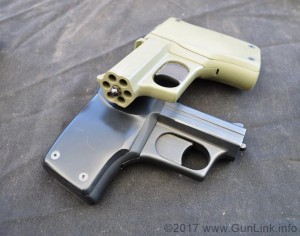 Although it resembles a pepperbox multi-barreled repeating revolver, the new Standard Mfg. S333 differs in that it operates by volley fire. More accurately, it uses a combination of repeating volley fire, firing two of its non-rotating six barrels – chambered in centerfire .25 ACP – at a time.
Although it resembles a pepperbox multi-barreled repeating revolver, the new Standard Mfg. S333 differs in that it operates by volley fire. More accurately, it uses a combination of repeating volley fire, firing two of its non-rotating six barrels – chambered in centerfire .25 ACP – at a time.
Two barrels at a time? Yeah, my first thought was machine gun too. However, Standard says that its not. For whatever reason, they would not elaborate that position to me any further than saying that “it is not a machine gun because it is volley fire.”
USC Title 26 Subtitle E Chapter 53 Subchapter B Part I, section 5845(b) of the NFA defines “machinegun” as “any weapon which shoots, is designed to shoot, or can be readily restored to shoot, automatically more than one shot, without manual reloading, by a single function of the trigger.” Maybe since it says “one shot” rather than “one projectile” this doesn’t count. Who knows? There is, however, an oft cited 2013 opinion letter that, in passing, mentions that volley guns are not machine guns (shown below). But we all know that ATF opinion letters are not worth the paper they’re printed on (right, Sig Sauer?).
Either way, the S333 is an interesting piece, if not a bit chunky. There is no manual safety, only a heavy stacking linear-pull double action trigger. The .25ACP round is anemic when compared to most other centerfire chamberings, but it will likely do better than some of the small rimfire contraptions. Although it has fairly prominent fixed sights atop it, who knows how accurate the multiple parallel barrels will be. Chances are, the designers didn’t have controlled aimed fire from any great distance in mind.
These are not available yet, but hopefully once they are we will get a chance to try one out.
Iver Johnson Four-Barreled Pocket Ace Derringer – .22 LR
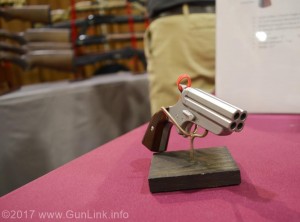 Another tiny piece reminiscent of something that might be found in the vest pocket of a 19th century gentleman is the new Pocket Ace derringer from Iver Johnson.
Another tiny piece reminiscent of something that might be found in the vest pocket of a 19th century gentleman is the new Pocket Ace derringer from Iver Johnson.
Similar in appearance to the Sharps 1860 Pepperbox or the later .22 Short rimfire Erl Svendsen 4 Aces derringer, which ceased product in the early 1970s, the Pocket Ace is chambered for rimfire .22 LR. As this is very similar to the Frontier Four that was rumored to be launching soon at SHOT Show several years ago, and there is not much trace of the Frontier Four online, our guess is that the FF didn’t successfully launch and this is its more refined successor.
The Pocket Ace features four sequentially-firing barrels which, as mentioned, are chambered in .22LR and slide off the front of the derringer for unloading/reloading.
Expected to be available in April of 2017, the Pocket Ace’s price is still TBD.






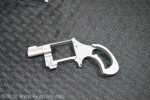

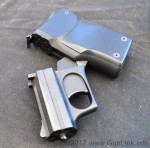
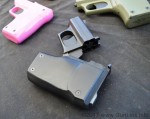
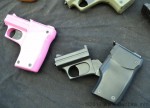

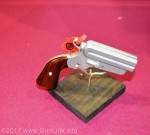


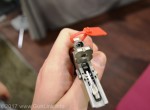






Pingback: I.O. Inc. Mini Revolver Makes Progress for 2018 | GunLink Blog